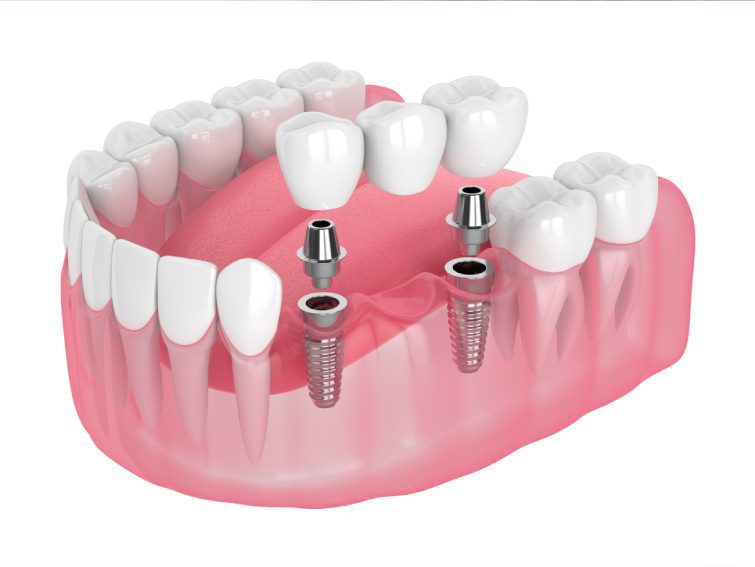
Download our dental implant pricing & information guide
Fill out the form below and we will email/text you the guide along with a $350 savings offer!

The guide will show you
- Dental Implant Options
- Average Pricing
- Factors that Affect Eligibility
- And More…
Replacing Consecutive Missing Teeth with
Implant-Supported Bridges
Implant-Supported Bridges
Implant-supported bridges can replace two or more missing teeth in a row, providing superior durability, stability, and oral health benefits compared to traditional bridges. Drs. Joe McIntyre and Dan Whiting at Smiles for Life Dental Care uses a computer-guided implant placement system for optimal precision during surgery. Additionally, our Bridgewater and Staunton, VA, practices accept multiple payment plan options, such as CareCredit™ and LendingClub, to help you afford the treatment option that best suits your oral health needs.

What Are the Advantages of Implant-Retained Bridges?
Implant-retained bridges provide patients with a number of unique advantages over traditional bridges, including:
- Preservation of adjacent teeth
- Long-term support
- Durability during conversation and meals
- Halting jawbone breakdown
- Preventing collapsed cheeks and lips, and other changes to the facial structure
As an additional bonus, caring for your implants is nearly identical to caring for your natural teeth. You do not need to learn new techniques or use special tools to keep your smile healthy.
What Are the Advantages of Implant-Retained Bridges?
Implant-retained bridges provide patients with a number of unique advantages over traditional bridges, including:
- Preservation of adjacent teeth
- Long-term support
- Durability during conversation and meals
- Halting jawbone breakdown
- Preventing collapsed cheeks and lips, and other changes to the facial structure
As an additional bonus, caring for your implants is nearly identical to caring for your natural teeth. You do not need to learn new techniques or use special tools to keep your smile healthy.
Am I a Candidate for Implant-Supported Bridges?
To evaluate your candidacy for dental implants, our dentists will perform a thorough oral evaluation and take detailed images of your teeth and adjacent oral structure. With this information, your dentist will decide if implants are the right treatment for you.
Most patients with two or more consecutively missing teeth and in good general health are eligible for implant-supported bridges. Some patient may initially be ineligible for implants due to poor jaw bone density. However, a bone graft can fortify the jaw enough to create a stronger foundation for implants.
Am I a Candidate for Implant-Supported Bridges?
To evaluate your candidacy for dental implants, our dentists will perform a thorough oral evaluation and take detailed images of your teeth and adjacent oral structure. With this information, your dentist will decide if implants are the right treatment for you.
Most patients with two or more consecutively missing teeth and in good general health are eligible for implant-supported bridges. Some patient may initially be ineligible for implants due to poor jaw bone density. However, a bone graft can fortify the jaw enough to create a stronger foundation for implants.
What Is It Like to Receive Implant-Supported Bridges?
On the day of your implant placement, you will be made comfortable with a local anesthetic. If necessary, we can also provide sedation options to help you relax during your appointment. After you are prepped, your dentist will make a small incision at the gum line and create a small hole in the jawbone. Your implants will be threaded through this portal and a temporary bridge may be attached.
What Is It Like to Receive Implant-Supported Bridges?
On the day of your implant placement, you will be made comfortable with a local anesthetic. If necessary, we can also provide sedation options to help you relax during your appointment. After you are prepped, your dentist will make a small incision at the gum line and create a small hole in the jawbone. Your implants will be threaded through this portal and a temporary bridge may be attached.
3-D computerized tomography (CT) scans...allows for high levels of accuracy in placing the implant...significantly reducing the risk of implant failure.
Our practice is proud to use 3-D computerized tomography (CT) scans to create surgical guides for placing the implants. This allows for high levels of accuracy in placing the implant, thereby speeding up healing times and significantly reducing the risk of implant failure.
When Will I Receive My Permanent Bridge?
In the four to six months after your implants are placed, the implant posts merge with the adjacent bone in a process called osseointegration. By fusing with the jawbone, the implant serves the function of a tooth root.
After osseointegration is complete, patients return to our practice to have an abutment attached. These devices connect the implant post to the permanent bridge. About two weeks after the abutments are placed, you will receive your permanent bridge. Your dentist will first check that the bridge matches the shade and shape of your natural teeth and fits comfortably with your bite patterns before attaching it to your implants.
Reach Out to Schedule a Consultation
Our dentists look forward to using their experience to improve your oral health and beautify your smile. Make your consultation by calling us at (540) 828-2312 or booking online. We serve patients from throughout the Staunton, Bridgewater, Harrisonburg, and Waynesboro area.
When Will I Receive My Permanent Bridge?
In the four to six months after your implants are placed, the implant posts merge with the adjacent bone in a process called osseointegration. By fusing with the jawbone, the implant serves the function of a tooth root.
After osseointegration is complete, patients return to our practice to have an abutment attached. These devices connect the implant post to the permanent bridge. About two weeks after the abutments are placed, you will receive your permanent bridge. Your dentist will first check that the bridge matches the shade and shape of your natural teeth and fits comfortably with your bite patterns before attaching it to your implants.
Reach Out to Schedule a Consultation
Our dentists look forward to using their experience to improve your oral health and beautify your smile. Make your consultation by calling us at (540) 828-2312 or booking online.






